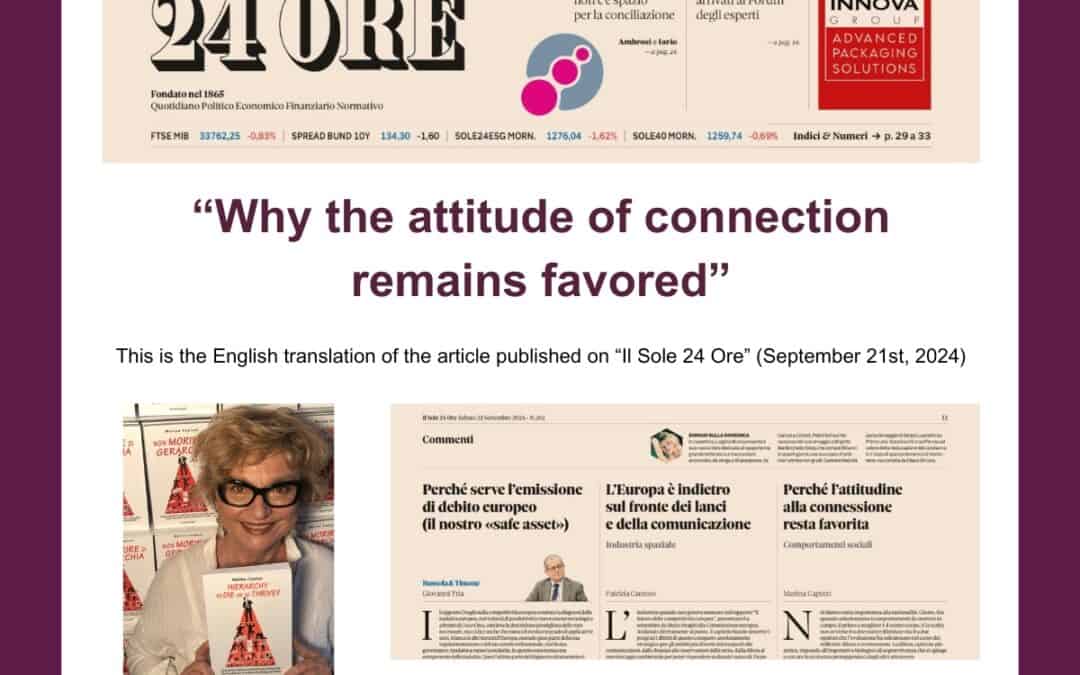We give so much importance to rationality. Right. But when we select which behaviors to deploy, the first choice is our body. And the choice is not between unlimited alternatives but between two options that evolution has selected over millennia: defense or connection
By Marina Capizzi
We give so much importance to rationality. Right. But when we select behaviors to put into action, the first choice is our body. And the choice is not between unlimited alternatives but between two options that evolution has selected over millennia: defense or connection. Defense, the older option, responds to the biological imperative of survival that drives us to seek safety by protecting ourselves from others through fight, flight or immobilization behaviors. The other option, much more recent in evolution, responds to the biological imperative of connectedness that drives us to create our safety together with others. Here we want to explore from a convenience perspective the two options that we humans possess by nature.
Our behaviors are selected by the Autonomic Nervous System (ANS), the radar of danger and safety signals that is not governed by rationality and is influenced by prior experiences. In practice we act defensive or connecting behaviors long before the brain has understood the situation.
What do we look like when we defend ourselves? We always keep the focus on danger (regardless of whether the threat is real or assumed), consider others “enemies,” and close ourselves off to protect ourselves. Slaves to the impulse to act or holed up because we feel trapped, we are less clear-headed. We stop listening and talking to each other. We write angry emails, we don’t reply. We always take the spotlight or, conversely, we don’t show up. We say “it’s his/her fault” and “it’s not my fault.” We turn meetings into battlegrounds or stand on the sidelines. We take impulsive decisions or procrastinate important ones. We erect walls, we become more and more territorial, we encroach on borders, we are willing to raise the level of conflict because, in order to feel safe, nothing is enough for us… mors tua vita mea. Assuming that there are situations in which, in the face of real danger, following the survival impulse saves us, we must be aware that constant reliance on defensive behaviors raises the stakes: more and more fight/ flight or isolation. The loop is self-feeding because, not feeling safe, we fail to stop and demand (mutually) that the other person take the first step. How do we feel in the meantime? Not well. Also, because we can find ourselves surrounded by ruins, metaphorical or real. Sure, we may have the satisfaction of lashing out, the taste of inflicting deadly blows on the enemy, but we can never relax. Why? Because we have to keep defending ourselves. And this keeps our ANS on constant alert preventing it from reaching the neural state that makes us feel physiologically safe. So we produce defensive hierarchies (of power, priorities, values, relationships, etc.) that feed the loop. In summary, when we are hostages to survival, our hierarchical power may increase but our governance weakens.
Evolution, however, has more recently selected another option: the biological imperative of connectedness. If you will, it is still about survival. But instead of seeking it “against” others, this option opens us up to others – even in the most critical moments – pushing us to co-create solutions and opportunities that enhance mutual security. When we are in this neural state, we reach out, we talk, we listen, we think together, we get straight to the point, gaining clarity and insight, we create novel solutions, we experiment with them, we use power differently… Why? Because when our ANS seek a shared security experience they generate connection, and we feel that we belong to a larger system. Challenges, difficulties, and threats unite us. Beware. This is not a “‘sedate paradise”. We can have frank confrontations, have hard-fought fights, get angry… but always curate connection because the hierarchies we create put the mutual security construct that allows us to co-regulate on top. This is the only neural state in which we feel good.
Research by neuroscientist S. Porges shows that the neural paths of connection and social engagement are the same ones that preside over our health and well-being. By the way: the imperative of connectedness appeared with mammals. May we be surprised? Mammals, in order to survive and thrive, must get through it together. That is why we come into the world already wired to connect. We humans starve for connection. That applies to individuals, organizations, countries.
